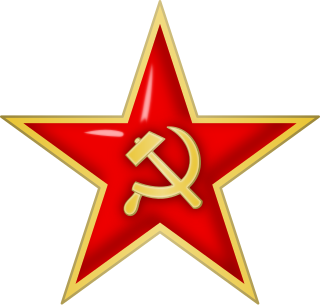The Southern Front was a front, a formation about the size of an army group of the Soviet Army during the Second World War. The Southern Front directed military operations during the Soviet occupation of Bessarabia and Northern Bukovina in 1940 and then was formed twice after the June 1941 invasion by Germany, codenamed Operation Barbarossa.
The German 206th Infantry Division, was a military unit that served during World War II. Like most German infantry units it had no motorization, and relied on leg and horse mobility.

The 1st Guards Army was a Soviet Guards field army that fought on the Eastern Front during World War II.
The 4th Army was a Soviet field army of World War II that served on the Eastern front of World War II and in the Caucasus during the Cold War. It was disbanded after the fall of the Soviet Union, with its divisions being withdrawn to Russia and disbanded.
The Bryansk Front was a major formation of the Red Army during the Second World War.
The 12th Army was a field army of the Red Army formed multiple times during the Russian Civil War and World War II.
The 18th Army of the Soviet Union's Red Army was formed on 21 June 1941 on the basis of HQ Kharkov Military District and armies of the Kiev Special Military District.

The 2nd Guards Tank Army was a large military formation of the Red Army and later the Soviet Army, now part of the Russian Ground Forces of the Russian Federation.
The 9th Army of the Soviet Union's Red Army was a Soviet field army, active from 1939 to 1943.

The 20th Guards Combined Arms Army is a field army. In 1991, after the dissolution of the Soviet Union, the army became part of the Russian Ground Forces. Military Unit Number в/ч 89425.

The 3rd Guards Tank Army was a tank army established by the Soviet Union's Red Army during World War II. The 3rd Tank Army was created in 1942 and fought in the southern areas of the Soviet Union and Poland, then in Germany and Czechoslovakia until the defeat of Germany in 1945. Postwar, the army served as occupation troops in East Germany, went through several name changes, and was finally deactivated in 1969.
The 3rd Shock Army was a field army of the Red Army formed during the Second World War. The "Shock" armies were created with the specific structure to engage and destroy significant enemy forces, and were reinforced with more armoured and artillery assets than other combined arms armies. Where necessary the Shock armies were reinforced with mechanised, tank, and cavalry units. During the Second World War, some Shock armies included armoured trains and air–sled equipped units.

The 11th Guards Army was a field army of the Red Army, the Soviet Ground Forces, and the Russian Ground Forces, active from 1943 to 1997.

Alexander Ilyich Lizyukov was a Soviet military leader holding the rank of major-general. He was awarded the title of Hero of the Soviet Union on 5 August 1941.
The 4th Shock Army was a combined arms army of the Soviet Armed Forces during World War II.
The 46th Army was a Soviet Red Army field army during World War II. The army was formed in August 1941 and guarded the Turkish border. During the summer of 1942, it fought in the Battle of the Caucasus. During the spring of 1943, the army helped capture Maykop and Krasnodar. During the summer of 1943, it fought in the Donbass Strategic Offensive and the Battle of the Dnieper. During early 1944, it fought in the Nikopol–Krivoi Rog Offensive and the Odessa Offensive. During the summer it fought in the Second Jassy–Kishinev Offensive. The army advanced westward and participated in the Battle of Debrecen and Budapest Offensive during the fall. After the fall of Budapest in February 1945, the army fought in the Vienna Offensive and the Prague Offensive. During the summer of 1945, the army moved to the Odessa Military District and was disbanded in September.

The 5th Shock Army was a Red Army field army of World War II. The army was formed on 9 December 1942 by redesignating the 10th Reserve Army. The army was formed two times prior to this with neither formation lasting more than a month before being redesignated.
The Soviet Airborne Troops formed a number of Airborne Corps during World War II.
The 5th Mechanised Corps was a mechanised corps of the Red Army, formed on three occasions. It was first formed in 1934 and was converted into the 15th Tank Corps in 1938. It was reformed in the Far East in 1940 and moved west before the German invasion of the Soviet Union. It fought in the First Battle of Smolensk, losing large numbers of tanks in the Lepel counterattack. The corps was encircled in the Smolensk pocket and after breaking out was disbanded in late August 1941. Its third formation, from elements of the 22nd Tank Corps, occurred in September 1942. The corps fought in: Operation Little Saturn, Operation Gallop, the Second Battle of Smolensk, the Dnieper–Carpathian Offensive, and the Second Jassy–Kishinev Offensive. In September 1944, it became the 9th Guards Mechanised Corps.
The 56th Army was a field army of the Soviet Union's Red Army that was created in 1941, and then disbanded to create the second formation of the Separate Coastal Army in 1943. The 56th Army was employed by the Soviets in the struggle against Germany during World War II.




